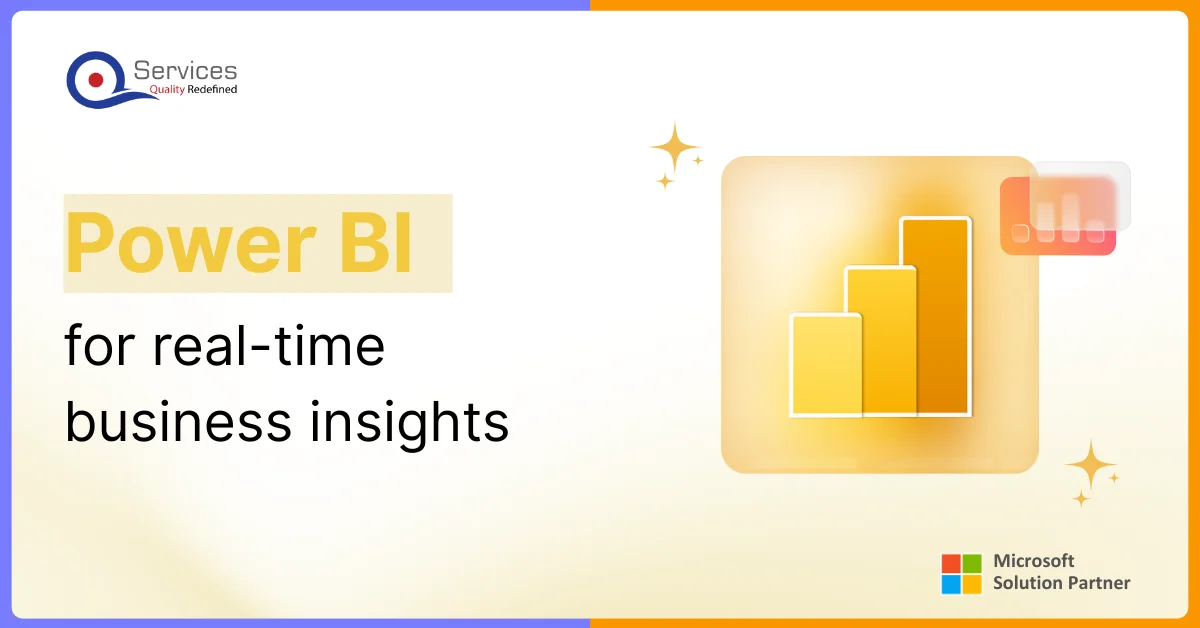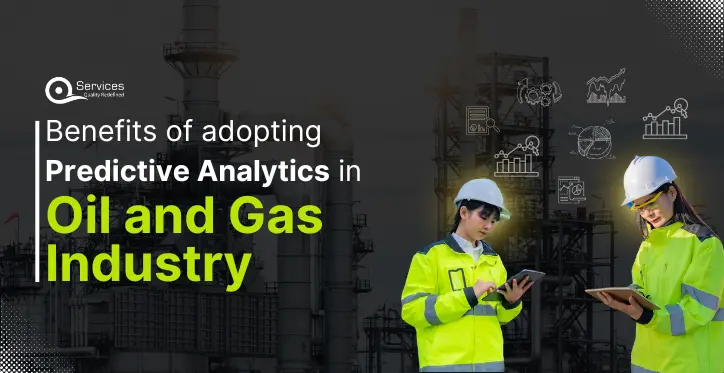
Home » Benefits of adopting predictive analytics in Oil and gas Industry

How do oil and gas companies make sure they’re not caught off guard by problems? They use predictive analytics oil and gas industry. This means they look at data from the past to predict future issues and prevent them. With the help of Azure data analytics, they can quickly process all that info and make smart decisions that keep things running smoothly. Whether it’s fixing equipment early or improving production, oil and gas predictive analytics helps companies avoid surprises and stay efficient.
Predictive analytics in oil and gas industry uses the power of data to predict what’s likely to happen in the future, so companies can act ahead of time. By analyzing historical data—such as equipment performance, operational records, and production rates—predictive models can highlight patterns that point to future failures or inefficiencies. This allows businesses to make smarter decisions, whether it’s scheduling maintenance before a breakdown happens or optimizing resource allocation to boost productivity.
With predictive analytics, companies can reduce unexpected downtime, lower maintenance costs, and work on improving overall operational performance, leading to better profitability and smoother operations in an industry that thrives on precision and efficiency. To improve operational efficiency, explore how Azure Digital Twins for predictive maintenance can transform your asset management.
In oil and gas, avoiding unplanned breakdowns can save a ton of money. Predictive analytics in oil and gas looks at past performance to forecast when equipment might fail, so businesses can fix things before they become a big issue. This keeps assets running longer and reduces downtime.
Leveraging Azure Analytics for Smarter Maintenance
Azure analytics services make this process even easier by using real-time data and machine learning to monitor equipment health. Predictive models can tell businesses when to schedule maintenance, so they’re not over-repairing or missing a problem before it becomes critical.
More Savings and Less Downtime
Using data analytics in oil and gas allows businesses to reduce cost by preventing expensive, unexpected repairs. The ability to predict when something will fail means companies can plan ahead, avoid downtime, and keep production going smoothly.
The oil and gas industry can’t afford to take risks when it comes to safety. Predictive analytics oil and gas industry tools are helping companies stay prepared by using data to predict potential issues. This means safer operations, better compliance, and fewer disruptions.
Oil & gas analytics is transforming how companies in the energy sector operate. Here’s how it’s helping companies become more efficient, safer, and cost-effective:
With oil & gas analytics, companies can use both historical and real-time data to make smarter drilling decisions. This helps to avoid unnecessary risks and improve production, making drilling operations more efficient.
One of the major benefits of oil & gas analytics is that it allows companies to keep track of equipment health. By predicting when maintenance is needed, companies and also can avoid unplanned downtime and keep equipment running smoothly for longer.
Oil & gas analytics also plays a big role in reducing safety risks. By predicting potential problems in advance, like equipment failures or hazardous conditions, companies can address them before they lead to accidents or operational shutdowns.
Through better planning and smarter resource allocation, oil & gas analytics helps companies avoid unnecessary spending. Predictive insights allow businesses to streamline operations, ultimately saving money and increasing profitability.
Get free Consultation and let us know your project idea to turn into an amazing digital product.
Predictive analytics is rapidly changing how the oil and gas industry operates. Here’s a look at what’s coming next:
By collecting data from different sources, businesses can create more accurate predictions to make insightful better decisions about operations and maintenance.
Real-time data will give companies the power to make quick decisions that improve efficiency and safety on the job.
Predictive algorithms will continue to evolve, helping companies avoid costly repairs and optimize production by predicting equipment failures and other issues ahead of time.
AI will find patterns that help guide decisions, while machine learning will continuously improve the accuracy of predictions.
Automation will help businesses reduce human error, save time, allowing employees to focus on more valuable tasks.
Predictive analytics requires high-quality, reliable data, which can be difficult to maintain in some oil and gas operations.
If sensor data from equipment or drilling activities is inconsistent or incomplete, it may result in poor predictions regarding equipment maintenance or production optimization.
Put in place automated systems for real-time data validation and cleansing to ensure data integrity and accuracy.
Integrating predictive analytics tools with older, legacy systems can be a major challenge, especially in an industry with complex infrastructure.
Older oil field systems may not be able to communicate with new predictive analytics platforms, creating roadblocks to implementation.
Take an approach to modern technology and ensure compatibility using middleware and integration solutions.
The workforce may not have the technical skills required to make the most of predictive analytics tools.
Field engineers or operators unfamiliar with data science might miss out on valuable predictive insights or misinterpret findings.
Provide ongoing training and education to equip employees with the necessary skills to utilize predictive analytics effectively.
Employees and management may resist the adoption of new technologies, particularly if they are unfamiliar with AI or machine learning-based predictions, Business analytics in oil and gas is quite helpful.
Staff may prefer traditional methods and doubt the reliability of AI in making accurate predictions for operations.
Lead with successful case studies, demonstrate clear benefits through pilot programs, and address concerns to foster greater acceptance of predictive analytics.

Predictive analytics is no longer a “nice-to-have” tool in the oil and gas industry, but a must-have. By using data to forecast challenges and optimize operations, companies can stay ahead of potential issues, improve efficiency, and cut down on unnecessary costs. Adopting predictive analytics today can give you the competitive edge needed to thrive in this fast-evolving industry.

Pipeline failures can be expensive and harmful to the environment. Companies are using IoT applications in the oil and gas industry to prevent these breakdowns and stay ahead of problems.
![Azure IoT vs AWS IoT vs Google IoT Pricing: Feature Comparison Chart for Enterprise [2025]](https://www.qservicesit.com/wp-content/uploads/2025/03/Microsoft-Teams-vs-Slack-vs-Zoom-TCO-Analysis-for-Enterprise-Organizations-2.webp)
The Internet of Things (IoT) helps businesses run better by connecting devices, collecting information, and improving choices. But picking the best IoT cloud provider can be confusing. The main three are AWS IoT vs Azure IoT vs Google IoT.

In this blog, we’ll explore how these advances are shaping the future of field services and how companies are adapting to stay ahead in a competitive market. What are the key changes that businesses need to embrace to stay relevant and efficient?
Predictive analytics involves using statistical models and machine learning techniques to analyze historical data and predict future outcomes. In the oil and gas sector, it helps companies anticipate equipment failures, optimize production processes, and enhance decision-making by providing actionable insights based on data patterns.
Predictive analytics improves safety by analyzing data related to equipment conditions, weather patterns, and historical safety records. This allows companies to identify potential hazards and implement preventative measures before incidents occur, thereby reducing risks associated with hazardous working environments
Yes, predictive analytics significantly enhances supply chain management by accurately forecasting demand-supply dynamics and optimizing logistics. This ensures that resources are allocated efficiently, minimizing costs associated with overstocking or shortages
Major companies like Shell and British Petroleum utilize predictive analytics for various applications:
Technologies include artificial intelligence (AI), machine learning (ML), Internet of Things (IoT), and advanced statistical modeling. These tools help analyze vast datasets to uncover insights that drive operational improvements.
The future of predictive analytics in this sector is expected to be shaped by further integration of AI, real-time data analysis, and digital technologies. This will enhance operational efficiency, reduce downtime, and improve decision-making capabilities across various functions within the industry
Artificial Intelligence in oil and gas is the use of computer systems to control and monitor oil and gas wells. Then machine learning is also used in oil and gas to predict the best places to drill.
ExxonMobil utilizes AI for predictive maintenance, exploration, smart supply chain, safety monitoring, and AI-powered energy solutions. This technology enhances operational efficiency, reduces costs, and drives innovation in oil, gas, and chemicals while supporting clean tech partnerships and digital transformation for both internal and external AI-powered sectors.

Founder and CEO

Chief Sales Officer
